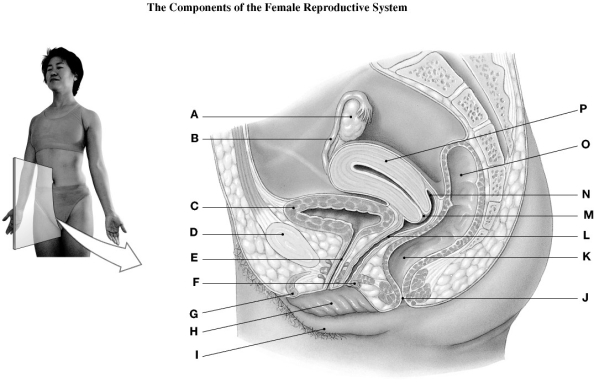A) spermatogonia.
B) secondary spermatocytes.
C) spermatids.
D) spermatozoans.
E) nurse cells.
G) All of the above
Correct Answer

verified
Correct Answer
verified
Short Answer
The first fluid to be secreted by the mammary glands following birth of an infant is called _________________________.
Correct Answer

verified
colostrum
Correct Answer
verified
Multiple Choice
Marissa is an avid jogger and she trains incessantly. She has slimmed down so that she is now underweight for her height and has very little fat tissue. You would expect Marissa to
A) have heavy menstrual flows.
B) double ovulate.
C) be amenorrheic (have no monthly menstrual flow) .
D) have painful menstrual cramps.
E) show elevated levels of FSH.
G) A) and D)
Correct Answer

verified
Correct Answer
verified
Short Answer
The procedure in which the prepuce is removed from the penis is called _________________________.
Correct Answer

verified
Correct Answer
verified
Multiple Choice
How many spermatozoa are produced during spermatogenesis?
A) one
B) two
C) four
D) six
E) eight
G) B) and D)
Correct Answer

verified
C
Correct Answer
verified
Short Answer
 Using the figure above, identify the labeled part.
-Label D: ________
Using the figure above, identify the labeled part.
-Label D: ________
Correct Answer

verified
Correct Answer
verified
Multiple Choice
The principal hormone secreted by the corpus luteum is
A) LH.
B) FSH.
C) progesterone.
D) estradiol.
E) estrogen.
G) C) and D)
Correct Answer

verified
Correct Answer
verified
Multiple Choice
Currently, another probable cause of up to 50 percent of all cases of pelvic inflammatory disease (PID) involves this genus of microorganism.
A) Chlamydia
B) Streptococcus
C) Mycobacterium
D) Lactobacillus
E) Staphylococcus
G) C) and D)
Correct Answer

verified
Correct Answer
verified
Multiple Choice
The clinical term for inflammation of the ovary is
A) glomerulonephritis.
B) testicular hypertrophy.
C) prostatitis.
D) nephritis.
E) follicular hypertrophy.
G) None of the above
Correct Answer

verified
Correct Answer
verified
Multiple Choice
Which of the following is an unpaired structure?
A) vas deferens
B) seminal vesicle
C) prostate gland
D) bulbourethral gland
E) corpus cavernosa
G) A) and C)
Correct Answer

verified
Correct Answer
verified
Short Answer
Sperm cells are produced by the process of _________________________.
Correct Answer

verified
spermatoge...View Answer
Show Answer
Correct Answer
verified
View Answer
Short Answer
The portion of the male urethra that passes through the penis is the _________________________ urethra.
Correct Answer

verified
Correct Answer
verified
Multiple Choice
The female structure that corresponds to the male penis is the
A) vagina.
B) clitoris.
C) vestibule.
D) labia minora.
E) labia majora.
G) A) and C)
Correct Answer

verified
Correct Answer
verified
Short Answer
The inner lining of the uterus is called the _________________________.
Correct Answer

verified
Correct Answer
verified
Short Answer
The _________________________ are finger-like projections at the end of the uterine tube.
Correct Answer

verified
Correct Answer
verified
Multiple Choice
This birth control strategy interferes with the female hormonal cycle so that ovulation does not occur.
A) vaginal barrier
B) intrauterine device (IUD)
C) rhythm method
D) diaphragm
E) oral contraceptives
G) All of the above
Correct Answer

verified
Correct Answer
verified
Multiple Choice
________ is characterized by failure of the testes to descend into the scrotum at the time of birth.
A) Impotence
B) Cryptorchidism
C) Sterility
D) Incontinence
E) Erectile dysfunction
G) C) and D)
Correct Answer

verified
B
Correct Answer
verified
Multiple Choice
During the secretory phase of the uterine (menstrual) cycle,
A) ovulation occurs.
B) a new functional layer is formed in the uterus.
C) secretory glands and blood vessels develop in the endometrium.
D) the old functional layer is sloughed off.
E) the corpus luteum is formed.
G) All of the above
Correct Answer

verified
Correct Answer
verified
Multiple Choice
The anterior enlargement of erectile tissue in females is the
A) fornix.
B) vestibule.
C) hymen.
D) clitoris.
E) isthmus.
G) D) and E)
Correct Answer

verified
Correct Answer
verified
Multiple Choice
For erection and ejaculation to occur,
A) there must be sufficient blood hydrostatic pressure leading to erectile tissue.
B) the parasympathetic and sympathetic branches of the nervous system must be properly functioning.
C) the urinary sphincters must be closed.
D) A and B only
E) all of the above
G) B) and E)
Correct Answer

verified
Correct Answer
verified
Showing 1 - 20 of 122
Related Exams